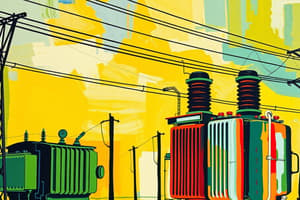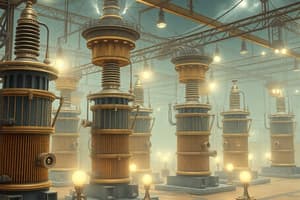Podcast
Questions and Answers
How does a transformer function?
How does a transformer function?
By converting electrical energy between two alternating current circuits
What are the main components of a transformer?
What are the main components of a transformer?
Core, Primary Winding, Secondary Winding
What is the primary function of the transformer core?
What is the primary function of the transformer core?
To serve as a support for the windings and reduce eddy currents
What is the purpose of the secondary winding in a transformer?
What is the purpose of the secondary winding in a transformer?
What phenomenon is involved in the working principle of a transformer?
What phenomenon is involved in the working principle of a transformer?
What is the primary function of a Step-up Transformer?
What is the primary function of a Step-up Transformer?
How does the design of the transformer core reduce eddy currents?
How does the design of the transformer core reduce eddy currents?
What is the efficiency of a transformer and why is it never 100%?
What is the efficiency of a transformer and why is it never 100%?
In what fields do transformers have applications?
In what fields do transformers have applications?
What principle do transformers operate based on?
What principle do transformers operate based on?
What are the two main types of transformers?
What are the two main types of transformers?
What is the purpose of the iron core in a transformer?
What is the purpose of the iron core in a transformer?
Why is the efficiency of a transformer never 100%?
Why is the efficiency of a transformer never 100%?
How does a Step-down Transformer differ from a Step-up Transformer?
How does a Step-down Transformer differ from a Step-up Transformer?
What measures are taken to reduce eddy currents in a transformer?
What measures are taken to reduce eddy currents in a transformer?
What is the main function of a transformer in the power transmission of electric energy?
What is the main function of a transformer in the power transmission of electric energy?
What is the primary function of the secondary winding in a transformer?
What is the primary function of the secondary winding in a transformer?
How do transformers facilitate the efficient transportation of electricity over long distances?
How do transformers facilitate the efficient transportation of electricity over long distances?
What is the purpose of using laminated silicon steel in the construction of the transformer core?
What is the purpose of using laminated silicon steel in the construction of the transformer core?
In power generation, what is the role of transformers in relation to voltage levels?
In power generation, what is the role of transformers in relation to voltage levels?
Explain the function of a Step-down Transformer in the distribution sector.
Explain the function of a Step-down Transformer in the distribution sector.
What principle allows transformers to transfer electricity between circuits with different voltage levels?
What principle allows transformers to transfer electricity between circuits with different voltage levels?
What are the primary applications of transformers in the field of power transmission?
What are the primary applications of transformers in the field of power transmission?
How does the primary winding in a transformer produce an alternating flux?
How does the primary winding in a transformer produce an alternating flux?
What is the main function of the core in a transformer?
What is the main function of the core in a transformer?
What is the significance of mutual flux in the operation of a transformer?
What is the significance of mutual flux in the operation of a transformer?
Flashcards are hidden until you start studying
Study Notes
Transformer Physics
A transformer is a device used in the power transmission of electric energy, commonly employed to increase or decrease the supply voltage without changing the frequency. Transformers are based on the principles of electromagnetic induction and mutual induction. They have various applications in power generation grids, distribution sectors, and electric energy consumption.
Working Principle
A transformer functions by converting electrical energy between two alternating current circuits. The main components of a transformer are:
- Core: The transformer core serves as a support for the windings and is made of laminated silicon steel to reduce eddy currents.
- Primary Winding: This winding is connected to the AC supply, producing an alternating flux known as mutual flux.
- Secondary Winding: This winding is connected to the load, and it induces a voltage in response to the mutual flux.
The working principle of a transformer involves mutual induction between the two windings. When an alternating current flows through the primary winding, it generates a magnetic field that induces a voltage in the secondary winding. The voltage difference between the primary and secondary windings can be used to power electrical loads.
Types of Transformers
Transformers can be classified based on various factors, such as working voltage range, medium used in the core, winding arrangement, and installation location. The most common types of transformers are:
- Step-up Transformer: These transformers increase the voltage from the primary circuit to the secondary circuit, with the secondary output voltage being higher than the input voltage.
- Step-down Transformer: These transformers decrease the voltage from the primary circuit to the secondary circuit, with the secondary output voltage being lower than the input voltage.
Efficiency
The efficiency of a transformer is never 100%, as some energy is lost as heat due to eddy currents in the iron core. To reduce these eddy currents, the core is made by sandwiching thin sheets of iron between non-conducting materials, such as insulating paper or epoxy resin. This design drastically reduces eddy currents and improves the transformer's efficiency.
Applications
Transformers have numerous applications in various fields, including power transmission and distribution, electric power supplies, and electrical devices. They are used to increase or decrease voltage levels, allowing for efficient and safe transportation of electricity over long distances.
In summary, transformers are essential devices in power transmission and distribution systems, enabling the efficient conversion of voltage levels for various applications. They operate based on the principles of electromagnetic induction and mutual induction, and their efficiency is crucial for minimizing energy losses in power transmission.
Studying That Suits You
Use AI to generate personalized quizzes and flashcards to suit your learning preferences.




